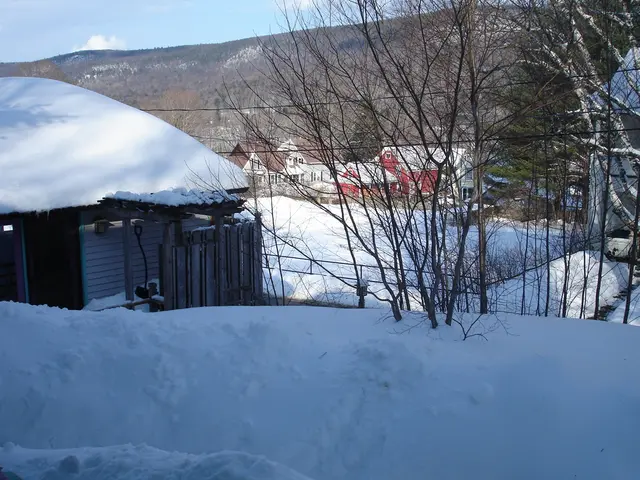Selling Bulletproof Vests Online: Are People Preparing for the Worst?
- By Gernot Kramper
- 4 Min
Understanding Emergency Preparedness in Germany: The Role of Bunker Building for Civil Defense - Germany Bunker Construction: Assessing Civil Defense in Crisis Scenarios
If you can buy a bulletproof vest for 599 euros from a discount store, it's cause for concern. Are people buying these vests out of fear of crime or the imminent arrival of "the Russians"? Demand for such products has increased since 2022, alongside the uncertainty caused by geopolitical tensions.
But what about civil defense in times of crisis? Germany still has 579 public shelters that serve as civil defense, according to the Federal Office for Civil Protection and Disaster Assistance (BBK). These shelters can house approximately 477,593 people. However, most of these spaces are not immediately operational. After the end of the Cold War, they were neglected, repurposed, or sold. With the stock in government hands, they could be reactivated. In countries like Switzerland, shelters provide space for almost their entire population.
Bunkers: Not Always the Answer
If these spaces are in optimal condition, they protect not only from bombs but are also equipped with air filters and can supply inhabitants with water and food for several days. However, they're not permanent doomsday bunkers designed for long-term survival, like those owned by the wealthy or government and military leaders. Such facilities would withstand direct attacks and protect residents for extended periods. Public shelters, on the other hand, provide limited protection in a nuclear war and long-term contamination - they would only delay the inevitable return to the surface by days to a maximum of two weeks. For massive atomic contamination, there's no protection available to the general population. In conventional attacks, these shelters can provide adequate protection.
Understanding the Threat: A Closer Look at the Ukraine Conflict
The mind often wanders to extreme scenarios, from nuclear wars to zombie apocalypse. In reality, the situation in the conflict between Russia and Ukraine can be better understood. Systematic bombardments of residential areas as a primary strategy are rare, with the focus usually on military targets. Nevertheless, there's significant damage to civilian areas, such as at the front lines, where cities and villages are literally leveled. Evacuations are attempted, but some civilians resist leaving. Drone attacks on energy infrastructure pose an indirect threat to the civilian population, but bomb shelters offer little protection against them.
No systematic attacks mean no civilian casualties? Not quite. In the battle between air defense and flying objects, "everything that goes up must come down." This applies to projectiles from machine guns and cannons, as well as intercepted or misguided flying bodies that crash on impact and may explode. A particularity of the Ukraine war is the blurred boundary between civilian and military use: military goods are often transported with civilian transporters and hidden in normal warehouses. Those near such locations are potentially at risk.
Implications for Germany
Even without a nuclear war or systematic bombing of residential areas, the population remains at risk from "incidental hits." Protection can be sought in public shelters, suitable cellars, or underground subway stations, as shown by images from the Kyiv metro. Occupants should bring their own cover, water, and supplies. Since cities are not completely destroyed and tactics like creating a firestorm are unlikely, such hits can be survived in many cellars. Even if the entrance is blocked, occupants can be rescued in time. The BBK recommends a 14-day emergency supply for power outages or evacuations.
The issue with this type of warfare is the exhaustion of the population. The sheer number of rockets, cruise missiles, and especially drones used against Ukraine is staggering. In potential future conflicts, even higher numbers can be expected - the era of truly industrial arms production is just beginning. In densely populated areas or near strategically important facilities, there may be air raid alerts night after night and day after day. Still, most people will eventually return to their homes when the danger subsides.
Alternative: Private Shelters
Some countries, like Switzerland and Finland, encourage the construction of private shelters; in some cases, it's even mandatory. In Germany, there are discussions about this approach. However, the costs associated with building a shelter are high. Even a simple, heavily reinforced cellar room with protected entrances and basic air supply costs at least 30,000 to 40,000 euros for a new build. More secure shelters with backup generators, water, food, and air filters can cost up to 100,000 euros. These facilities only offer short-term protection and aren't designed for long-term survival.
Preparing for the Worst: Essential Steps
Stockpiling essential items for emergencies - food, water, and backup power sources - is a cost-effective alternative to building a shelter. A simple bulletproof vest with steel plates can provide protection against handguns but may hinder the wearer more than protecting them in a knife attack. It's ineffective against military opponents in the Ukraine war, who typically wear vests with groin protectors to defend against attacks to the lower abdomen. If ground combat reaches your own city, however, a bulwark of any kind would prove useful.
- Bunker
- Civil defense
- Emergency preparedness
- Federal Office for Civil Protection and Disaster Assistance
- Bulletproof vest
- Military conflict
- Air raid defense
- The Federal Office for Civil Protection and Disaster Assistance (BBK) reports that Germany has several civil defense shelters, but most are not immediately operational due to neglect or repurposing post-Cold War.
- In Switzerland, public shelters can house almost the entire population, raising questions about the adequacy of Germany's civil defense infrastructure in times of crisis.
- A bulletproof vest, while providing protection against handguns, may not be effective against military opponents in conflicts like the one in Ukraine. Building private shelters can offer short-term protection, but the cost can range from 30,000 to 100,000 euros, and they are not designed for long-term survival.







